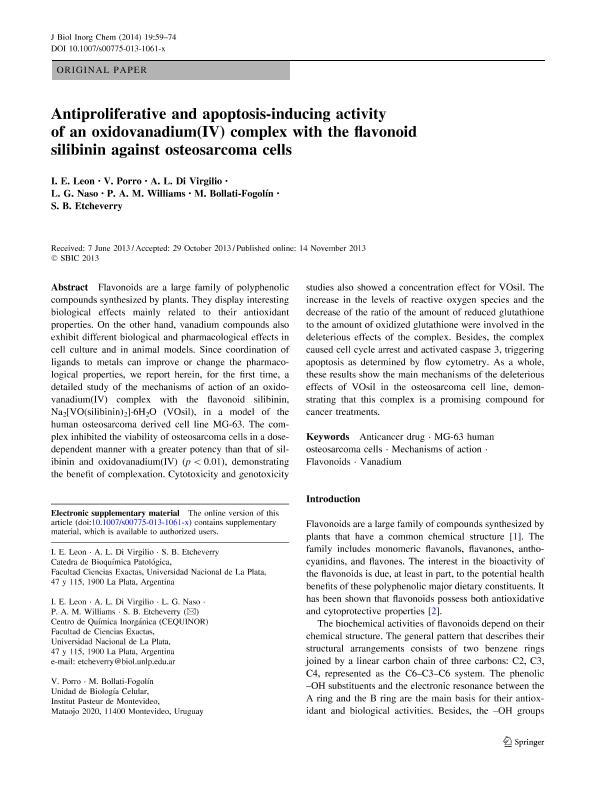Mostrar el registro sencillo del ítem
dc.contributor.author
Leon, Ignacio Esteban

dc.contributor.author
Porro, V
dc.contributor.author
Di Virgilio, Ana Laura

dc.contributor.author
Naso, Luciana Gissella

dc.contributor.author
Williams, Patricia Ana María

dc.contributor.author
Bollati Fogolin, M.
dc.contributor.author
Etcheverry, Susana Beatriz

dc.date.available
2017-09-22T18:52:49Z
dc.date.issued
2014-02
dc.identifier.citation
Leon, Ignacio Esteban; Porro, V; Di Virgilio, Ana Laura; Naso, Luciana Gissella; Williams, Patricia Ana María; et al.; Antiproliferative and apoptosis-inducing activity of an oxidovanadium(IV) complex with the flavonoid silibinin against osteosarcoma cells; Springer; Journal of Biological Inorganic Chemistry; 19; 1; 2-2014; 59-74
dc.identifier.issn
0949-8257
dc.identifier.uri
http://hdl.handle.net/11336/24972
dc.description.abstract
Flavonoids are a large family of polyphenolic compounds synthesized by plants. They display interesting biological effects mainly related to their antioxidant properties. On the other hand, vanadium compounds also exhibit different biological and pharmacological effects in cell culture and in animal models. Since coordination of ligands to metals can improve or change the pharmacological properties, we report herein, for the first time, a detailed study of the mechanisms of action of an oxidovanadium(IV) complex with the flavonoid silibinin, Na2[VO(silibinin)2]6H2O (VOsil), in a model of the human osteosarcoma derived cell line MG-63. The complex inhibited the viability of osteosarcoma cells in a dosedependent manner with a greater potency than that of silibinin and oxidovanadium(IV) (p\0.01), demonstrating the benefit of complexation. Cytotoxicity and genotoxicity studies also showed a concentration effect for VOsil. The increase in the levels of reactive oxygen species and the decrease of the ratio of the amount of reduced glutathione to the amount of oxidized glutathione were involved in the deleterious effects of the complex. Besides, the complex caused cell cycle arrest and activated caspase 3, triggering apoptosis as determined by flow cytometry. As a whole, these results show the main mechanisms of the deleterious effects of VOsil in the osteosarcoma cell line, demonstrating that this complex is a promising compound for cancer treatments.
dc.format
application/pdf
dc.language.iso
eng
dc.publisher
Springer

dc.rights
info:eu-repo/semantics/openAccess
dc.rights.uri
https://creativecommons.org/licenses/by-nc-sa/2.5/ar/
dc.subject
Anticancer Drug
dc.subject
Mg-63 Human Osteosacrcoma Cells
dc.subject
Mechanisms of Action
dc.subject
Flavonoids
dc.subject
Vanadium
dc.subject.classification
Bioquímica y Biología Molecular

dc.subject.classification
Ciencias Biológicas

dc.subject.classification
CIENCIAS NATURALES Y EXACTAS

dc.title
Antiproliferative and apoptosis-inducing activity of an oxidovanadium(IV) complex with the flavonoid silibinin against osteosarcoma cells
dc.type
info:eu-repo/semantics/article
dc.type
info:ar-repo/semantics/artículo
dc.type
info:eu-repo/semantics/publishedVersion
dc.date.updated
2017-09-18T14:29:07Z
dc.journal.volume
19
dc.journal.number
1
dc.journal.pagination
59-74
dc.journal.pais
Alemania

dc.journal.ciudad
Berlin
dc.description.fil
Fil: Leon, Ignacio Esteban. Universidad Nacional de la Plata. Facultad de Cs.exactas. Departamento de Cs.biológicas. Cátedra Bioquímica Patologica; Argentina. Consejo Nacional de Investigaciones Científicas y Técnicas. Centro Científico Tecnológico Conicet - La Plata. Centro de Química Inorgánica "Dr. Pedro J. Aymonino". Universidad Nacional de La Plata. Facultad de Ciencias Exactas. Centro de Química Inorgánica "Dr. Pedro J. Aymonino"; Argentina
dc.description.fil
Fil: Porro, V. Instituto Pasteur de Montevideo; Uruguay
dc.description.fil
Fil: Di Virgilio, Ana Laura. Universidad Nacional de la Plata. Facultad de Cs.exactas. Departamento de Cs.biológicas. Cátedra Bioquímica Patologica; Argentina. Consejo Nacional de Investigaciones Científicas y Técnicas. Centro Científico Tecnológico Conicet - La Plata. Centro de Química Inorgánica "Dr. Pedro J. Aymonino". Universidad Nacional de La Plata. Facultad de Ciencias Exactas. Centro de Química Inorgánica "Dr. Pedro J. Aymonino"; Argentina
dc.description.fil
Fil: Naso, Luciana Gissella. Consejo Nacional de Investigaciones Científicas y Técnicas. Centro Científico Tecnológico Conicet - La Plata. Centro de Química Inorgánica "Dr. Pedro J. Aymonino". Universidad Nacional de La Plata. Facultad de Ciencias Exactas. Centro de Química Inorgánica "Dr. Pedro J. Aymonino"; Argentina
dc.description.fil
Fil: Williams, Patricia Ana María. Consejo Nacional de Investigaciones Científicas y Técnicas. Centro Científico Tecnológico Conicet - La Plata. Centro de Química Inorgánica "Dr. Pedro J. Aymonino". Universidad Nacional de La Plata. Facultad de Ciencias Exactas. Centro de Química Inorgánica "Dr. Pedro J. Aymonino"; Argentina
dc.description.fil
Fil: Bollati Fogolin, M.. Instituto Pasteur; Francia
dc.description.fil
Fil: Etcheverry, Susana Beatriz. Universidad Nacional de la Plata. Facultad de Cs.exactas. Departamento de Cs.biológicas. Cátedra Bioquímica Patologica; Argentina. Consejo Nacional de Investigaciones Científicas y Técnicas. Centro Científico Tecnológico Conicet - La Plata. Centro de Química Inorgánica "Dr. Pedro J. Aymonino". Universidad Nacional de La Plata. Facultad de Ciencias Exactas. Centro de Química Inorgánica "Dr. Pedro J. Aymonino"; Argentina
dc.journal.title
Journal of Biological Inorganic Chemistry

dc.relation.alternativeid
info:eu-repo/semantics/altIdentifier/doi/http://dx.doi.org/10.1007/s00775-013-1061-x
dc.relation.alternativeid
info:eu-repo/semantics/altIdentifier/url/https://link.springer.com/article/10.1007%2Fs00775-013-1061-x
Archivos asociados
